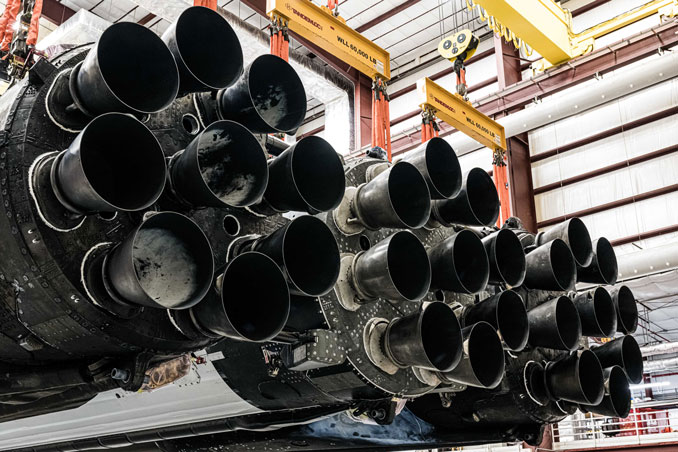
The Falcon Heavy for the USSF 52 mission to launch the U.S. military’s X-37B spaceplane inside the hangar at launch complex 39A at the Kennedy Space Center. Image: SpaceX.
Following two Falcon 9 launches from both California and Florida, SpaceX closed out the first weekend of December with a Falcon Heavy static fire test. The ignition of the 27 Merlin engines came a week ahead of the planned launch of a national security mission that has been on the books for half a decade.
The U.S. Space Systems Command said the USSF-52 mission is targeting liftoff no earlier than Sunday, Dec. 10. The launch window has not been announced publicly. It will be the first time the Falcon Heavy has conducted a launch for the U.S. military’s secretive X-37B spaceplane project. It will be the eighth Falcon Heavy launch to date and the seventh mission for the X-37B Orbital Test Vehicle.
U.S. Space Systems Command noted that this will be the fifth mission in 2023 for the Assured Access to Space (AATS) Directorate:
USSF-67 – Jan. 15 (Falcon Heavy, SpaceX)
GPS III-6 – Jan. 18 (Falcon 9, SpaceX)
NROL-68 – June 21 (Delta 4 Heavy, ULA)
NROL-107 – Sept. 10 (Atlas 5, ULA)
USSF-52 – NET Dec. 10 (Falcon Heavy, SpaceX)
“Our national security space launches transport our most important capabilities into orbit,” said Brig. Gen. Kristin Panzenhagen, Program Executive Officer for AATS and Commander, Space Launch Delta 45, in a statement. “We partner closely with our launch service providers, and the entire team is focused on executing a successful mission.”
The launch contract was awarded to SpaceX as part of the Phase 1A National Security Space Launch (NSSL) procurement. The launch contract with SpaceX for this mission is valued at about $155 million according to SSC and will feature side boosters that are flying for their fifth time.
“We benefit greatly from our partnerships with other government agencies and from commercially derived developments,” said Dr. Walt Lauderdale, Mission Director and lead for Falcon Systems and Operations at SSC, in a statement. “When we look at the upswing in the launch tempo, adapting to change is our standard operating procedure that gives us the capacity and throughput we will need to support future national security space requirements.”
After the boosters are recovered, SpaceX and NASA officials said they will be used for a sixth and final time to launch NASA’s Europa Clipper mission to the moon of Jupiter in October 2024.
Following the Falcon Heavy launch mid-month, the pad at LC-39A will be converted back to a Falcon 9 configuration in preparation for the launch of a Nova-C lunar lander as part of the Intuitive Machines and NASA mission, IM-1 heading to the Moon’s South Pole.


 Cryptopolitan_News
Cryptopolitan_News DeFi Planet
DeFi Planet TheCoinrise Media
TheCoinrise Media DogeHome
DogeHome CoinoMedia
CoinoMedia COINTURK NEWS
COINTURK NEWS Cryptopolitan_News
Cryptopolitan_News Optimisus
Optimisus TheCoinrise Media
TheCoinrise Media






















